Grouping Control Strategy for Battery Energy Storage Power Stations Considering the Wind and Solar Power Generation Trend
Abstract
:1. Introduction
2. Wind–Solar Energy Storage Microgrid System
3. Power Distribution of Battery Energy Storage Power Stations Considering the Wind and Solar Power Generation Trend
3.1. SOC Consistency Algorithm Based on Multi-Agent
3.2. Determining Energy Storage Charging and Discharge Grouping Situation Based on Probability Distribution
3.3. Energy Storage Output Strategy Considering the Degradation Characteristics of Battery Life
- (1)
- When the power station is in a non-discharge state ()
- (2)
- When the power station is in a discharge state ()
4. Simulation Analysis
4.1. Scene Description and Parameter Setting
4.2. Simulation Results
4.3. Simulation Analysis
5. Conclusions
- (1)
- A strategy of energy storage output considering battery life was designed, in which the started energy storage units are selected first, and then the power allocated by each unit is determined. This strategy uses as few battery units as possible and ensures the accurate tracking of the scheduling plan.
- (2)
- A grouping method considering the positive and negative fluctuation probability of energy storage power was proposed. Compared with the average grouping used in the existing research, it can reduce the temporary conversion times of charging and discharging and further prolong the power station operation life.
- (3)
- Aiming at the power distribution between the started units, an SOC consistency algorithm based on multi-agent was used. Compared with the power distribution mode of power average distribution, the SOC values among energy storage units tend to be more consistent in the scheduling period.
Author Contributions
Funding
Data Availability Statement
Conflicts of Interest
Nomenclature
| Abbreviation | Meaning | Units |
| Power command of the battery energy storage power station | MW | |
| Scheduling instruction | MW | |
| The output power of wind turbines | MW | |
| The output power of photovoltaic arrays | MW | |
| Scheduling instruction | MW | |
| Scheduling interval | h | |
| Remaining capacity of the energy storage unit | ||
| Rated capacity of the energy storage unit | ||
| The output power of the th energy storage unit | MW | |
| Charging efficiency of the energy storage unit | - | |
| Discharging efficiency of the energy storage unit | - | |
| The number of starting energy storage units | - | |
| Weight parameter | - | |
| Starting identifier | - | |
| Connection relationship between the th energy storage unit and the th energy storage unit | - | |
| Rated discharge power of the energy storage unit | MW | |
| State transition identifier | - | |
| Rated discharge power of the charging and discharging group | MW | |
| The number of energy storage units in the charging and discharging group | - | |
| The minimum SOC of a single energy storage unit | - | |
| The maximum SOC of a single energy storage unit | - | |
| The ratio of the charging group and discharging group | MW/MW | |
| The number of energy storage units | - | |
| Battery energy storage unit number | - |
References
- Li, X.; Lyu, L.; Geng, G.; Jiang, Q.; Zhao, Y.; Ma, F.; Jin, M. Power allocation strategy for battery energy storage system based on cluster switching. IEEE Trans. Ind. Electron. 2022, 69, 3700–3710. [Google Scholar] [CrossRef]
- Yu, Y.; Chen, D.Y.; Wu, Y.W.; Li, J.L.; Wang, B.X. Power allocation strategy considering SOC balance and income for battery energy storage in smoothing wind power fluctuations. High Volt. Eng. 2022, 8, 86. [Google Scholar] [CrossRef]
- Yan, G.G.; Cai, C.X.; Duan, S.M.; Li, H.B.; Liu, Y.; Li, J.H. Operation control strategy of microgrid considering grouping optimization of battery energy storage units. Autom. Electr. Power Syst. 2020, 44, 38–46. [Google Scholar]
- Guo, W.; Zhao, H.S. Grouping control strategy of battery energy storage array based on DMPC weighted consensus algorithm. Electr. Power Autom. Equip. 2020, 40, 133–140. [Google Scholar]
- Zhao, Y.; Shi, X.W.; Wang, L.B.; Liu, H.M.; Yang, J.F. Power allocation strategy of large-scaled battery energy storage power station. Power Syst. Technol. 2022, 46, 5004–5012. [Google Scholar]
- Zou, J.; Shu, J.; Zhang, Z.; Luo, W. An Active power allocation method for wind-solar-batteries hybrid power system. Electr. Mach. Power Syst. 2014, 42, 1530–1540. [Google Scholar] [CrossRef]
- Li, X.; Ma, R.; Yan, N.; Wang, S.; Hui, D. Research on Optimal Scheduling Method of Hybrid Energy Storage System Considering Health State of Echelon-Use Lithium-Ion Battery. IEEE Trans. Appl. Supercond. 2021, 31, 0604204. [Google Scholar] [CrossRef]
- Li, G.; Yang, Z.; Li, B.; Bi, H. Power allocation smoothing strategy for hybrid energy storage system based on Markov decision process. Appl. Energy 2019, 241, 152–163. [Google Scholar] [CrossRef]
- Fu, H.; Lu, P.; Zhang, J.N. Allocation Strategy of DC Microgrid All Vanadium Redox Flow Battery Energy Storage System Based on A-SA-WOA Algorithm. Trans. China Electrotech. Soc. 2023. [Google Scholar] [CrossRef]
- Li, D.; Wu, Z.; Zhao, B.; Zhang, L. An Improved Droop Control for Balancing State of Charge of Battery Energy Storage Systems in AC Microgrid. IEEE Access 2020, 8, 71917–71929. [Google Scholar] [CrossRef]
- Wang, W.X.; Duan, J.D.; Zhang, R.S.; Guo, H. Optimal state-of-charge balancing control for paralleled battery energy storage devices in islanded microgrid. Trans. China Electrotech. Soc. 2015, 30, 126–135. [Google Scholar]
- Kakigana, H.; Miura, Y.; Ise, T. Distribution voltage control for DC microgrids using fuzzy control and gain scheduling technique. IEEE Trans. Power Electron. 2013, 28, 2246–2258. [Google Scholar] [CrossRef]
- Li, C.D.; Coelho, E.A.; Dragicevi, T.; Guerrero, J.M.; Vasquez, J.C. Multiagentbased distributed state of charge balancing control for distributed energy storage units in AC microgrids. IEEE Trans. Ind. Appl. 2017, 53, 2369–2381. [Google Scholar] [CrossRef]
- Jiang, Q.Y.; Gong, Y.Z.; Wang, H.J. A battery energy storage system dual-layer control strategy for mitigating wind farm fluctuations. IEEE Trans. Power Syst. 2013, 18, 3263–3273. [Google Scholar] [CrossRef]
- Tan, S.C.; Zhang, H.; Xiao, X.; Zhi, N. A power sharing method based on SOC unbalanced degree for energy storage. Power Electron. 2016, 50, 57–59. [Google Scholar]
- Nguyen, C.L.; Lee, H.H. A novel dual-battery energy storage system for wind power applications. IEEE Trans. Ind. Electron. 2016, 63, 6136–6147. [Google Scholar] [CrossRef]
- Lin, L.; Jia, Y.; Ma, M.; Jin, X.; Zhu, L.; Luo, H. Long-term stable operation control method of dual-battery energy storage system for smoothing wind power fluctuations. Int. J. Electr. Power Energy Syst. 2021, 129, 106878. [Google Scholar] [CrossRef]
- Long, B.J.; Zhang, J.; He, Y.; Cheng, R.; Fan, L.; Li, B.; Gu, T.; Fu, X.; Li, H. Grouping consistency control strategy based on DMPC and energy storage unit constraints. Power Syst. Prot. Control 2022, 50, 23–36. [Google Scholar]
- Yu, Y.; Chen, D.Y.; Wang, B.X.; Wu, Y.W.; Lu, W.T.; Mi, Z.Q. Control scheme to extend lifetime of BESS for assisting wind farm to track power generation plan based on wind power feature extraction. IET Power Electron. 2022, 15, 1629–1651. [Google Scholar] [CrossRef]
- Zhao, H.S.; Guo, W. Hierarchical Distributed Coordinated Control Strategy for Hybrid Energy Storage Array System. IEEE Access 2018, 7, 2364–2375. [Google Scholar] [CrossRef]
- Guo, W.; Zhao, H.S. Grouping Control Strategy of Battery Energy Storage Array System Based on an Improved Distributed Consensus Algorithm. Trans. China Electrotech. Soc. 2019, 34, 4991–5000. [Google Scholar]
- Yu, Y.; Chen, D.Y.; Wu, Y.W.; Wang, B.X.; Cai, X.L.; Dong, K. Grouping control strategy of battery energy storage for reducing life loss under wind power tracking scheduling plan. Electr. Power Autom. Equip. 2022, 9, 16. [Google Scholar] [CrossRef]
- Yang, T.; Yu, M.; Fang, F. State-of-charge balancing control for battery energy storage system based on event-triggered scheme. Appl. Phys. A Mater. Sci. Process. 2019, 125, 339. [Google Scholar] [CrossRef]
- Qi, D.; Hu, J.H.; Liang, X.L.; Zhang, J.Q.; Zhang, Z.H. Research on consensus of multi-agent systems with and without input saturation constraints. J. Syst. Eng. Electron. 2021, 32, 947–955. [Google Scholar]
- Trejo, J.; Rotondo, D.; Medina, M.A.; Trejo, J.A.V.; Beltrán, C.D.G.; Morales, J.G. Robust Observer-based Leader-Following Consensus for Multi-agent Systems. IEEE Lat. Am. Trans. 2021, 19, 1949–1958. [Google Scholar] [CrossRef]
- Wang, B.; Cai, G.; Yang, D. Dispatching of a Wind Farm Incorporated with Dual-Battery Energy Storage System Using Model Predictive Control. IEEE Access 2020, 8, 144442–144452. [Google Scholar] [CrossRef]
- Li, X.J.; Hui, D.; Lai, X.K. Battery Energy Storage Station (BESS)-Based Smoothing Control of Photovoltaic (PV) and Wind Power Generation Fluctuations. IEEE Trans. Sustain. Energy 2013, 4, 464–473. [Google Scholar] [CrossRef]
- Tankari, M.A.; Camara, M.B.; Dakyo, B.; Lefebvre, G. Use of ultracapacitors and batteries for efficient energy management in wind-diesel hybrid system. IEEE Trans. Sustain. Energy 2013, 4, 414–424. [Google Scholar] [CrossRef]
- Yan, G.G.; Zhu, X.X.; Li, J.W.; Mu, G.; Luo, W.H. Control Strategy Design for Hybrid Energy Storage System with Intrinsic Operation Life Measurement and Calculation. Autom. Electr. Power Syst. 2013, 37, 110–114. [Google Scholar]
- Lou, S.H.; Yi, L.; Wu, Y.W.; Hou, T. Optimizing Deployment of Battery Energy Storage Based on Lifetime Predication. Trans. China Electrotech. 2015, 30, 265–271. [Google Scholar]
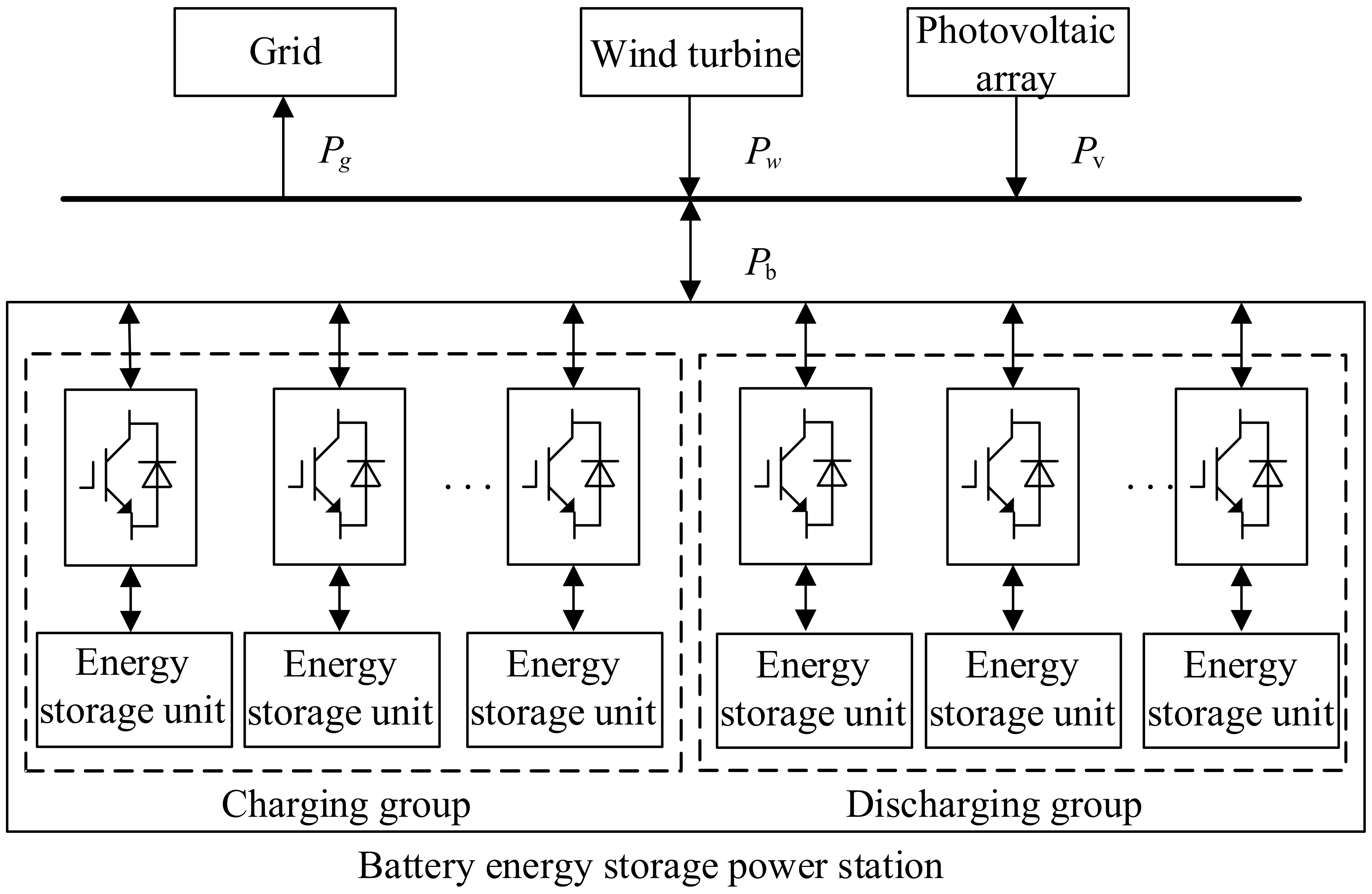
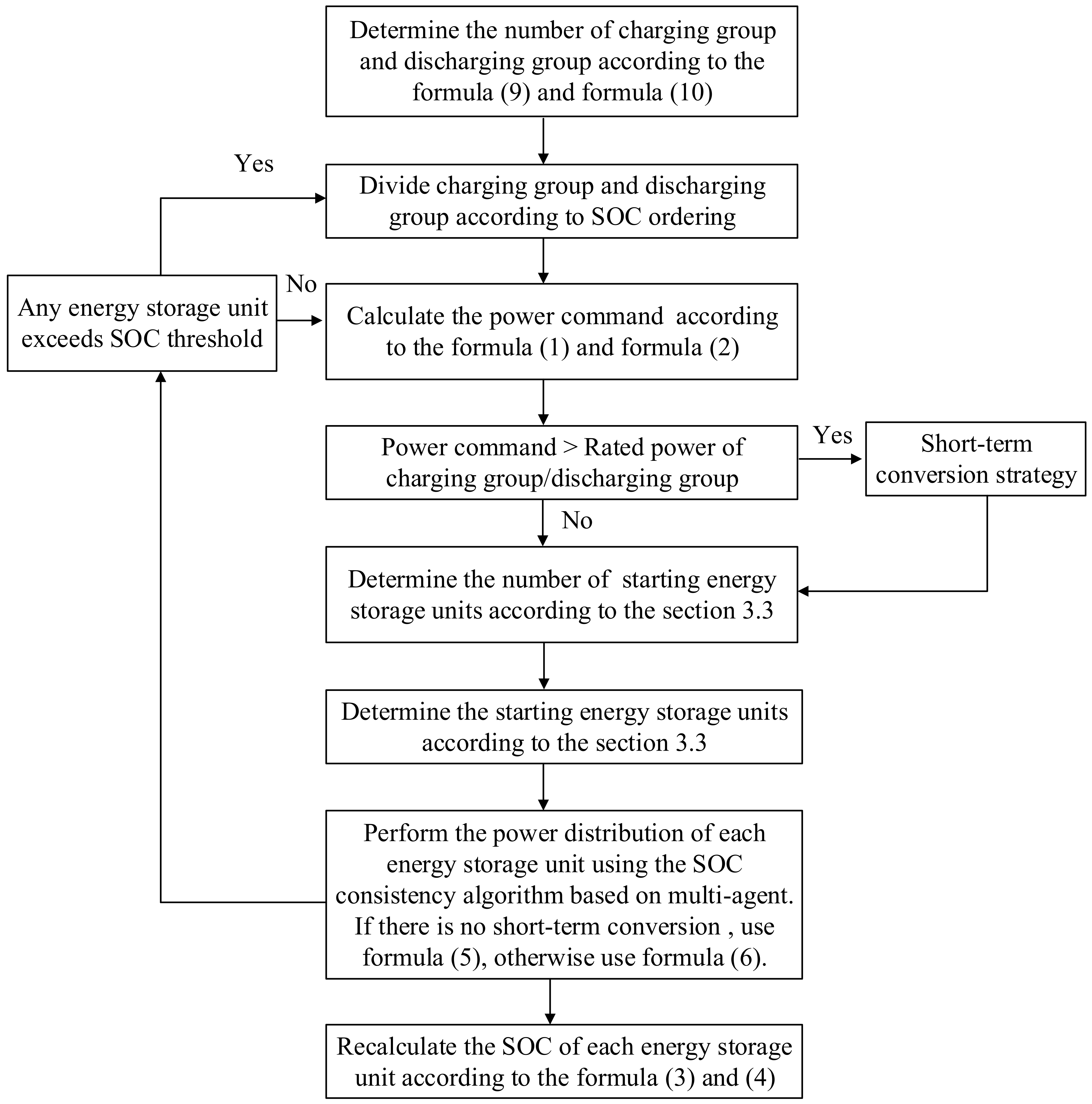
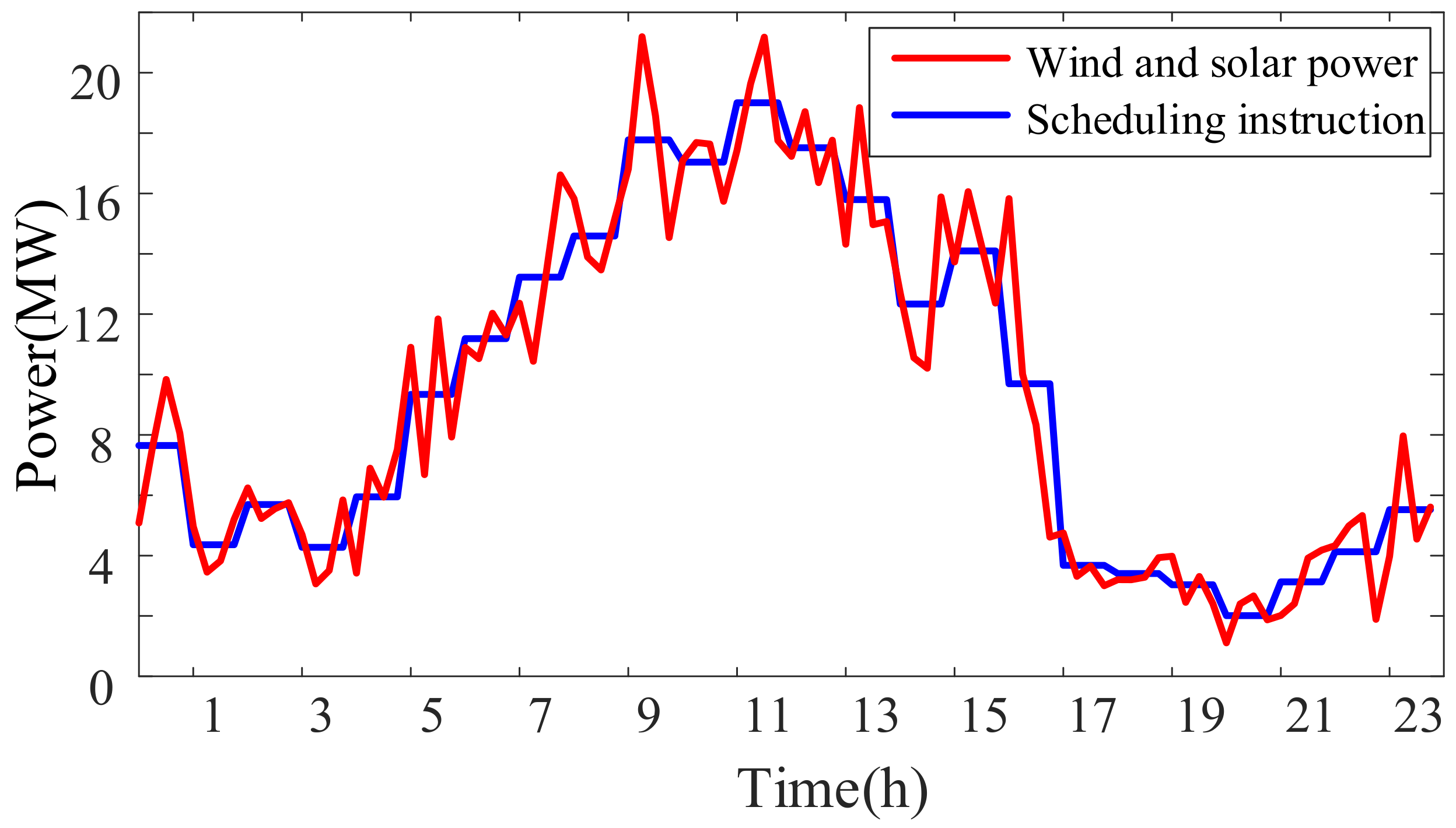
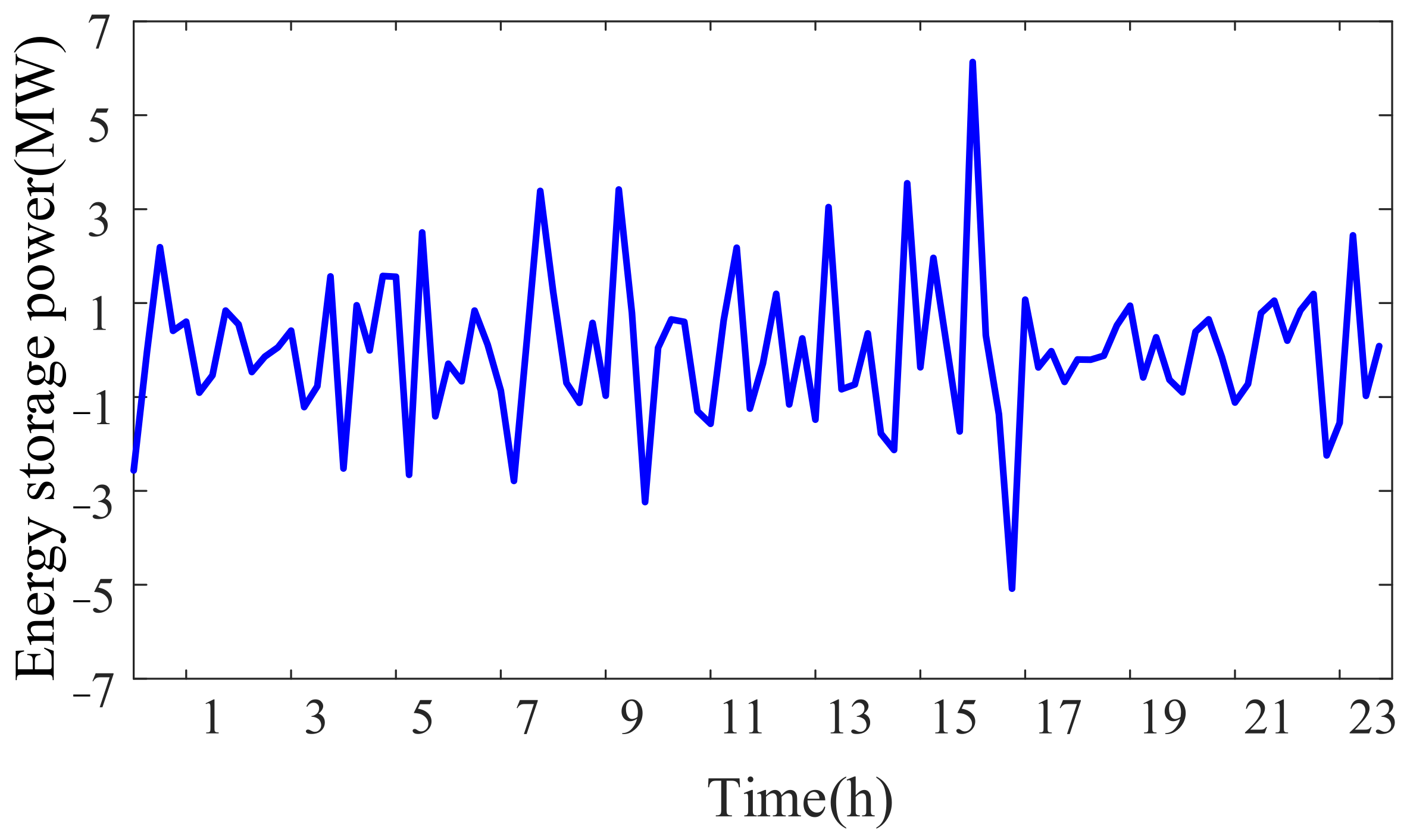

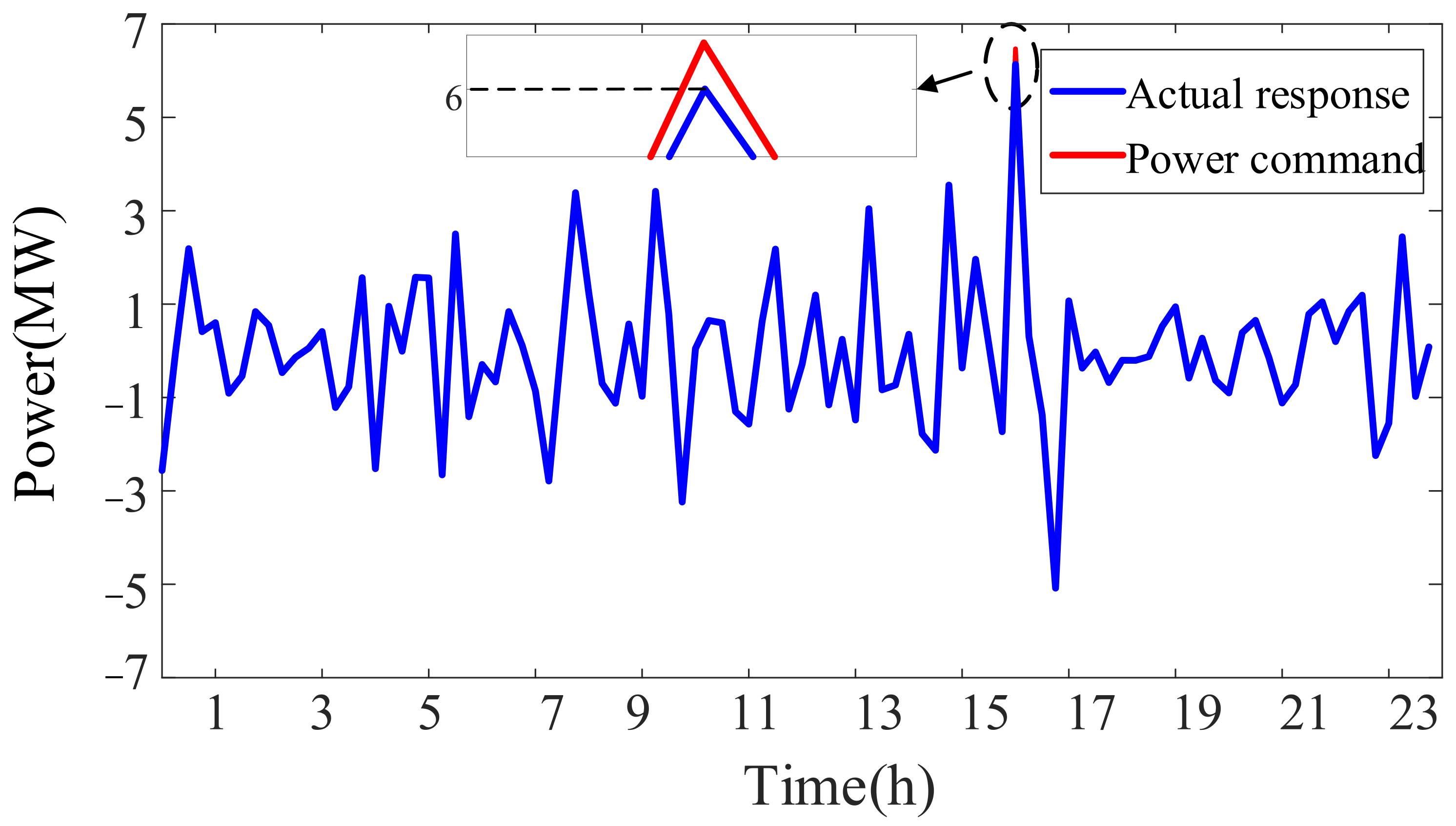

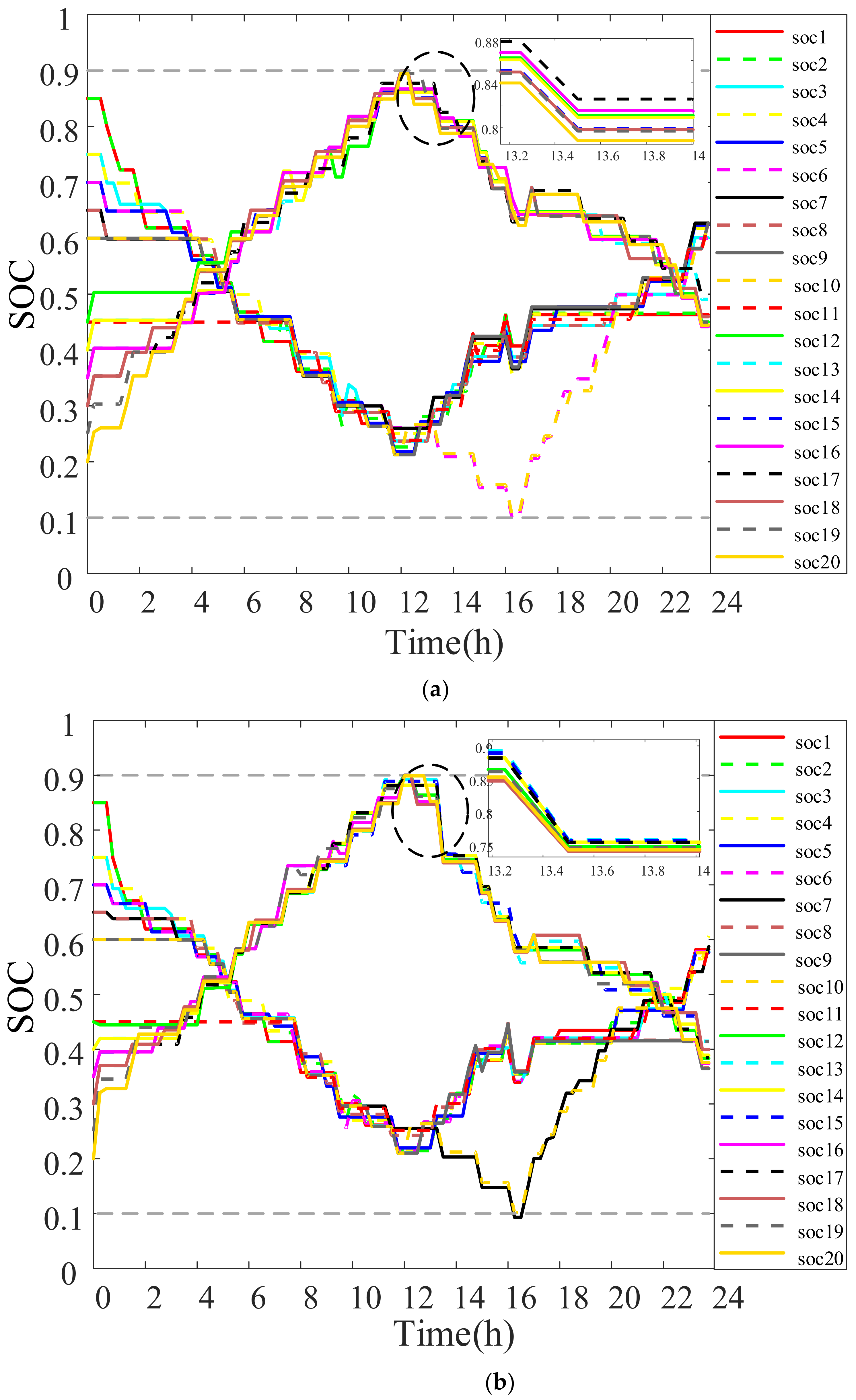
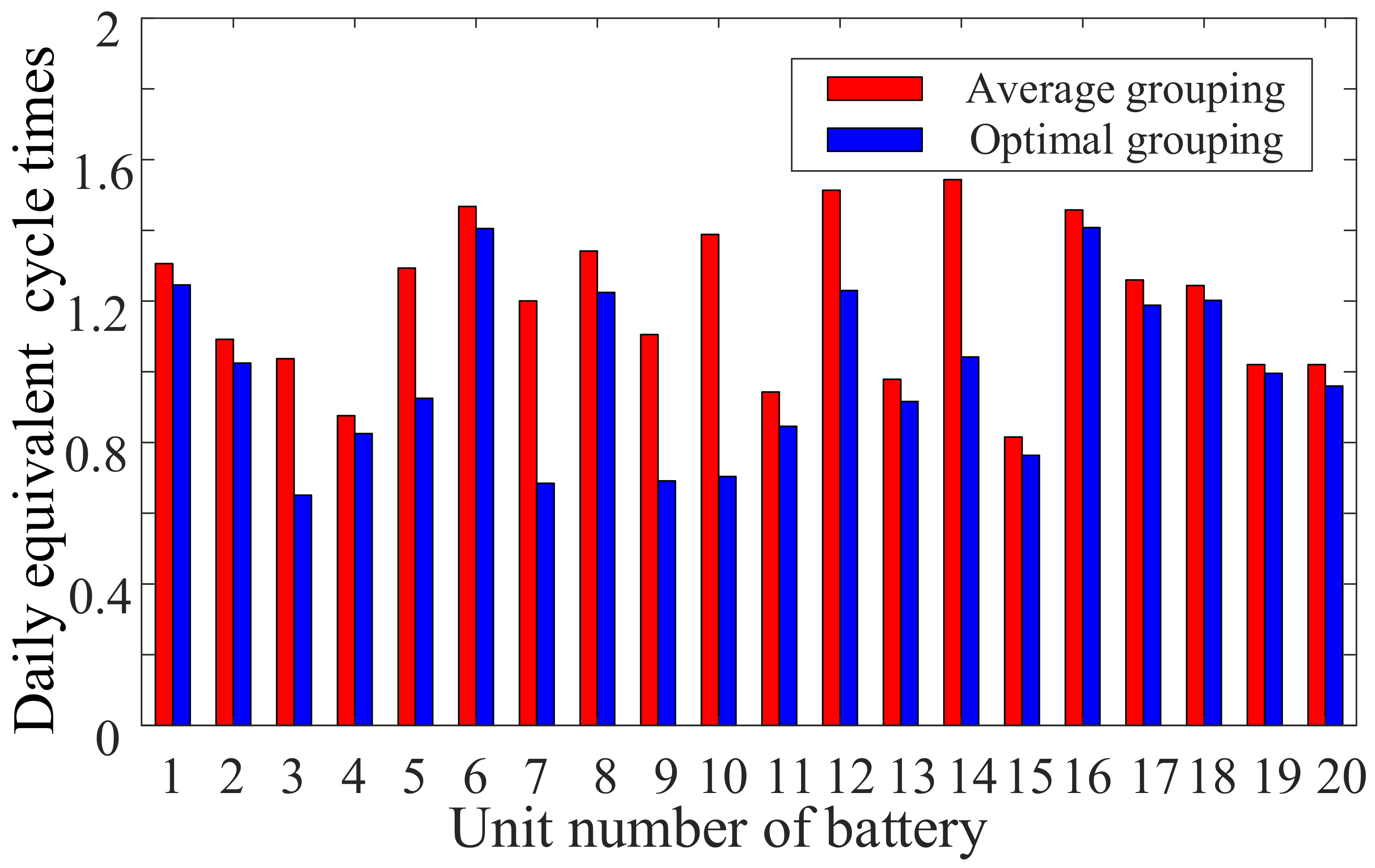
| Parameter | Values |
|---|---|
| Number of energy storage units | 20 |
| Rated capacity of energy storage unit/(MW·h) | 1.2 |
| Rated power of energy storage unit/MW | 0.3 |
| Efficiency of charging and discharging (%) | 90 |
| 0.9/0.1 |
| Unit Number | Initial SOC | Unit Number | Initial SOC |
|---|---|---|---|
| No.1 | 0.85 | No.11 | 0.45 |
| No.2 | 0.85 | No.12 | 0.45 |
| No.3 | 0.75 | No.13 | 0.4 |
| No.4 | 0.75 | No.14 | 0.4 |
| No.5 | 0.7 | No.15 | 0.35 |
| No.6 | 0.7 | No.16 | 0.35 |
| No.7 | 0.65 | No.17 | 0.3 |
| No.8 | 0.65 | No.18 | 0.3 |
| No.9 | 0.6 | No.19 | 0.25 |
| No.10 | 0.6 | No.20 | 0.2 |
Disclaimer/Publisher’s Note: The statements, opinions and data contained in all publications are solely those of the individual author(s) and contributor(s) and not of MDPI and/or the editor(s). MDPI and/or the editor(s) disclaim responsibility for any injury to people or property resulting from any ideas, methods, instructions or products referred to in the content. |
© 2023 by the authors. Licensee MDPI, Basel, Switzerland. This article is an open access article distributed under the terms and conditions of the Creative Commons Attribution (CC BY) license (https://creativecommons.org/licenses/by/4.0/).
Share and Cite
Guo, W.; Fan, W.; Zhao, Y.; An, J.; He, C.; Guo, X.; Qian, Y.; Ma, L.; Zhao, H. Grouping Control Strategy for Battery Energy Storage Power Stations Considering the Wind and Solar Power Generation Trend. Energies 2023, 16, 1857. https://doi.org/10.3390/en16041857
Guo W, Fan W, Zhao Y, An J, He C, Guo X, Qian Y, Ma L, Zhao H. Grouping Control Strategy for Battery Energy Storage Power Stations Considering the Wind and Solar Power Generation Trend. Energies. 2023; 16(4):1857. https://doi.org/10.3390/en16041857
Chicago/Turabian StyleGuo, Wei, Wenyi Fan, Yang Zhao, Jiakun An, Chunguang He, Xiaomei Guo, Yanan Qian, Libo Ma, and Hongshan Zhao. 2023. "Grouping Control Strategy for Battery Energy Storage Power Stations Considering the Wind and Solar Power Generation Trend" Energies 16, no. 4: 1857. https://doi.org/10.3390/en16041857
APA StyleGuo, W., Fan, W., Zhao, Y., An, J., He, C., Guo, X., Qian, Y., Ma, L., & Zhao, H. (2023). Grouping Control Strategy for Battery Energy Storage Power Stations Considering the Wind and Solar Power Generation Trend. Energies, 16(4), 1857. https://doi.org/10.3390/en16041857




